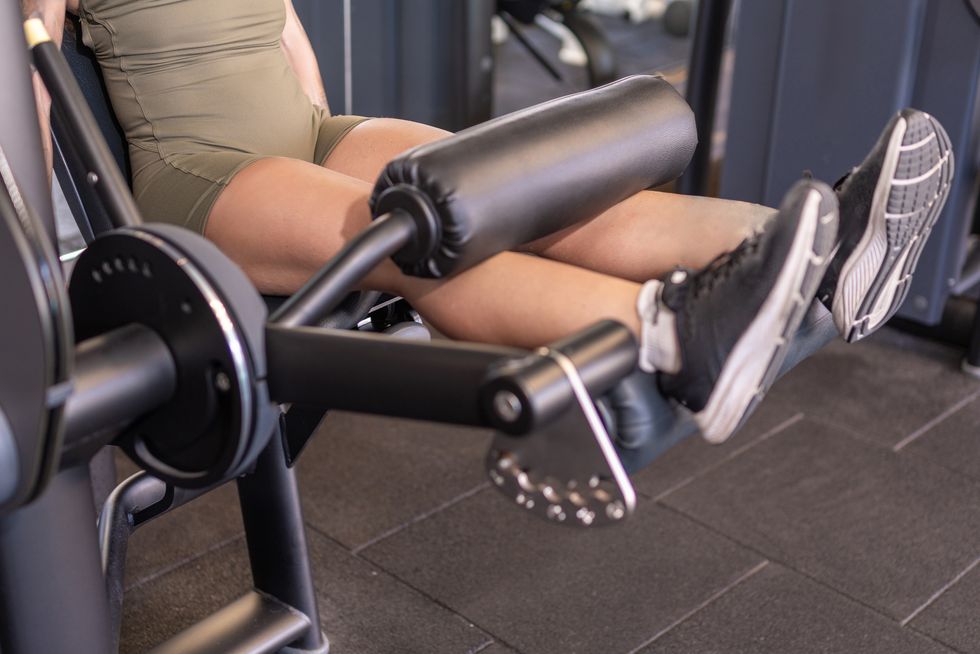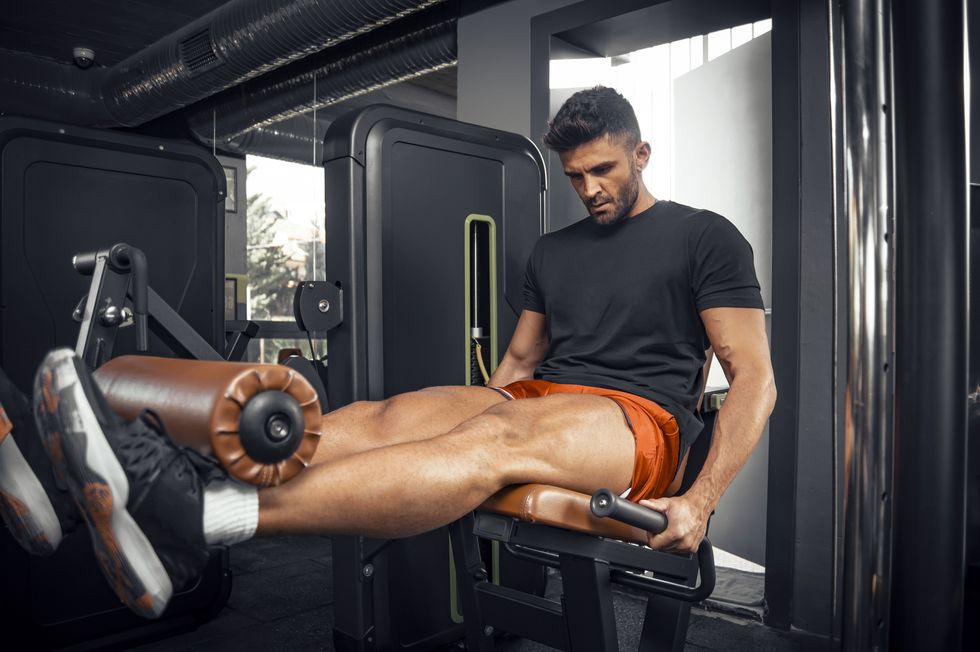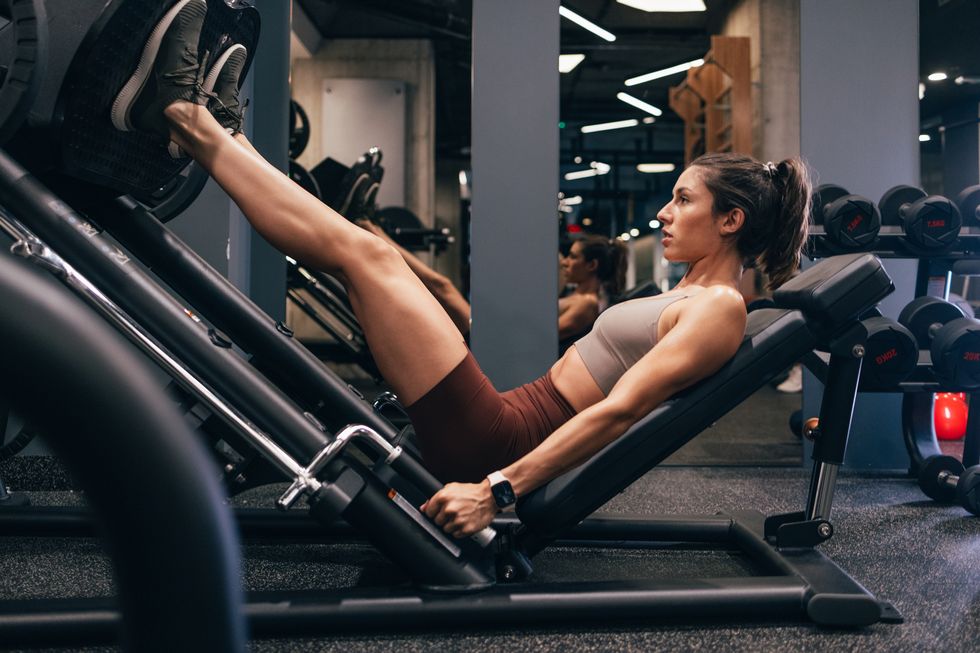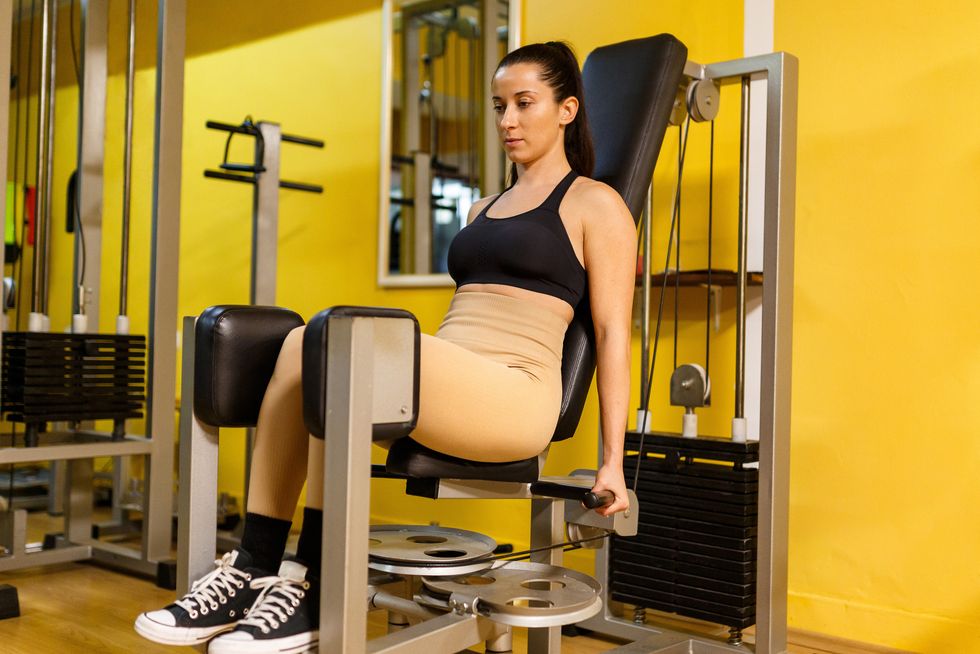When used properly, strength training on a machine can help you reach your goals.

Arturo Peña Romano Medina//Getty Images
Besides clocking a few kilometres here and there on the treadmill, the gym may not be the first place that comes to mind when you think about reaching your PR. However, taking advantage of strength-training opportunities at a gym can have a positive affect on your speed and endurance.
“Strength training for runners is crucial as it helps improve muscle imbalances, enhances stability, and reduces the risk of injuries,” Ellen Thompson, NASM-CPT, head personal trainer at Blink Fitness in New York City tells Runner’s World. “It also contributes to better running economy and overall performance by increasing power and efficiency in stride mechanics.”
Science backs this up: A 2016 review in The Journal of Strength & Conditioning Research found that strength training performed two to three times per week for eight to 12 weeks can improve running economy (how efficiently you use oxygen and energy while running) in highly trained middle- and long-distance runners.
While you don’t need weight machines to strength train, they can help you get started in a safe environment, considering they provide stability and a predetermined path of motion. That said, eventually incorporating other functional movements and free weights into your routine may allow for more strength in a full range of motion, core and balance training, and muscle coordination.
In other words, weight machines may be ideal for those new to weightlifting, but eventually you’ll want to progress to equipment like dumbbells, barbells, or kettlebells.
“If I was doing a machine chest press, that would then progress to a barbell or dumbbell bench press,” says Steven Stonehouse, NASM-CPT, a run coach and vice president of programming and education at Body Fit Training and STRIDE Fitness in Irvine, California.
Benefiting from weight machines starts with knowing the proper way to use them and choosing the right ones—particularly leg machines. Here are the four leg machines experts recommend for runners. When using these, Stonehouse recommends three sets of 10 to 12 reps as a general rule of thumb.
4 Best Leg Machines for Runners
1. Leg Curl Machine
 turk_stock_photographer//Getty Images
turk_stock_photographer//Getty Images
Why it works: “The leg curl machine is important for strengthening the hamstring and muscles around it to help create overall stability during a run,” says Thompson.
Strong hamstrings are critical for runners. They play a key role in stabilising the knee joint, which prevents injuries like strains and tears. They also contribute to better running mechanics and overall performance, especially for sprinting and hill running, says Thompson.
You may see even more benefits if you focus on single-leg versions of these movements. “When you’re running, you are on one leg 95 percent of the time,” says Stonehouse. “I like to train that way, too.”
How to use it:
- Opt for either a seated or lying leg curl machine.
- If sitting, place feet on top of the leg roller with legs straight, then push the weight down, bending knees. If you’re lying facedown, place our feet under the roller and pull the weight up, bending knees.
- Straighten legs back out.
- Repeat.
2. Leg Extension Machine
 salihkilic//Getty Images
salihkilic//Getty Images
Why it works: The leg extension machine looks similar to a leg curl machine, but the roller pad is positioned lower to target the quads. Your quads support the knee joint, helping to absorb the impact of each stride when you’re running.
“Well-developed quads contribute to overall knee stability, reducing the risk of injuries like patellofemoral pain syndrome [a.k.a. runner’s knee],” says Thompson. “Strong quadriceps also improve running efficiency and power during uphill sections—and work to control the descent when running downhill. This in turn helps to keep the knees from buckling.”
How to do it:
- Place the roller pad under ankles. Press back firmly against the seat and grab both handles for stability.
- Raise the weight to hip height, straightening the knees.
- Bend the knees back down.
- Repeat.
3. Leg Press Machine
 FreshSplash//Getty Images
FreshSplash//Getty Images
Why it works: “A leg press machine will best simulate a general squat movement,” says Stonehouse. “It works the hips, quads, and hamstrings. You’ll also get some core strengthening, too.”
In addition to the benefits of lower-body strength, core strength is important because it helps to stabilize your spine and prevent injury. Strengthening your core can improve posture endurance, respiration, and efficiency while running.
How to do it:
- Lie with back flat against the seat, and place feet on the platform above, shoulder-width apart.
- Bend knees to a 90-degree angle, as you lower the weight toward you, making sure knees don’t cave in.
- Pause for a few seconds or immediately straighten legs.
- Repeat.
4. Abductor Machine
 Nemanja Mohenski//Getty Images
Nemanja Mohenski//Getty Images
Why it works: “This is good for your glutes and core,” says Thompson. Many runners tend to have weak or inactive glutes—which can lead to lower back pain as well as loss of power on the run—and this machine helps fire them up, especially the gluteus medius, an important muscle for pelvic stability. The key here is not going too heavy.
How to do it:
- Sit with knees inside pads.
- Hold the handles for support and keep back pressed against the seat.
- Press legs outward.
- Slowly return to center.
- Repeat.
3 Weight Machines to Skip as a Runner
Not all weight machines in the gym will benefit you equally. Here are the ones our experts recommend skipping.
1. Ab Rotation Machine
This works the abs and lower back, which you can better target without a weight machine.
“I’ve found that certain machines can be restrictive and limit some of the natural motion in these target areas for some body types or sizes,” says Stonehouse. “I’d find ways to strengthen these areas from the ground.”
For example, in lieu of an ab rotation machine, you could work your abs by doing moves like leg lifts, plank shoulders taps, or bicycle crunches—or incorporate rotational work into leg movements (like adding a rotation to a lunge).
2. Dip Machine
The dip machine involves using your triceps to push down weights, but the risks may outweigh the benefits.
“It’s a sweeping generalization, but I’m not sure this movement is necessary for runners,” says Stonehouse. “I always look at risk and reward. Dips can put a lot of stress on your shoulders and, for runners, the benefit just isn’t there.”
3. Shoulder Press Machine
Rather than spending time on weight machines that target specific arm movements, incorporate arm strengthening into total-body training.
For example, lower-body exercises like squats can also strengthen your arms and shoulders as you hold a weight up. You could also incorporate an overhead press into your squat, which targets your entire body in one movement.
“It’s best to do exercises where your body trains as one unit,” says Thompson. “When deciding what to use, ask yourself: ‘What’s my goal? Is this machine relevant to what I’m trying to do?’”
5 Tips for Using Weight Machines as a Runner
1. Increase Weight Appropriately
While you don’t want to overextend yourself, if you’re easily flying through reps, it’s time to increase the weight.
“If you’re using a weight that is so light that you can do more than 15 reps, you probably need to go heavier,” says Stonehouse.
2. Switch Things Up
Incorporate weight machines into your routine two to three times per week—not every day.
“Doing something once does not induce enough stimulus where your body will need to rebuild and become stronger,” says Thompson. Aim to do the same or similar upper-body and lower-body exercises for four weeks to see progress.
With any weight-training exercise, Thompson adds that it’s important to add variety at that one-month mark (for instance, you might switch from barbell squats to double kettlebell squats)—otherwise, your body will adapt and the exercise will stop inducing stimulus to grow strength.
When it comes to frequency, remember that more isn’t always better. Plus, if you’re a runner, the majority of your training should focus on mileage. “In this case, the main goal is your running, and strength training is intended to support the running—not the other way around,” says Stonehouse.
3. Cut Back Before a Race
While everyone is different, Thompson recommends focusing on rest and recovery (and putting more emphasis on mobility) than using weight machines in the days leading up to a race.
“Foam roll or use a massage gun if you have one,” says Thompson. “See if you can touch your toes with your feet together and knees straight. This is a good way to see if anything is tight.” This recovery, along with getting at least seven hours of sleep per night, is most important right before a race.
4. Be Patient With Your Progress
Just like running, strength training takes time and patience.
“Sometimes people will get really frustrated when they first start strength training because they get sore or don’t know what to do,” says Stonehouse. “Don’t bail on it right away. Expect there to be a learning curve and be patient, because you’re not going to get extremely strong overnight.”
While seeing results is subjective by person, you may start feeling the results of your strength training two to four weeks after starting.
5. Work Rest Into Your Routine
Although work-to-rest ratios will vary based on the intention of the training session, Stonehouse says one general rule of thumb is to lift weights and rest in a 1:1 ratio.
For instance, if it takes you 45 seconds to complete an exercise, then rest for 45 seconds before starting your next round. That said, you might rest less between sets on days when you’re moving lighter loads or if you’re doing something like supersets or circuit training.
“Recovery time helps to replenish energy stores, reduce fatigue, and maintain proper form during subsequent exercises, ultimately optimizing the effectiveness of your workout and minimizing the risk of overtraining or injury,” says Thompson.